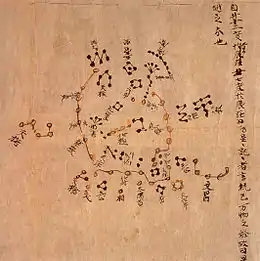Dunhuang Star Chart
The Dunhuang map or Dunhuang Star map is one of the first known graphical representations of stars from ancient Chinese astronomy, dated to the Tang Dynasty (618–907). Before this map, much of the star information mentioned in historical Chinese texts had been questioned.[2] The map provides a graphical verification of the star observations, and are part of a series of pictures on one of the Dunhuang manuscripts. The astronomy behind the map is explained in an educational resource posted on the website of the International Dunhuang Project, where much of the research on the map has been done.[3] The Dunhuang Star map is to date the world's oldest complete preserved star atlas.[4]

History
Early in 1900s (decade), a walled-up cave containing a cache of manuscripts was discovered by Chinese Taoist Wang Yuan-lu in the Mogao Caves. The scroll with the star chart was found amongst those documents by Aurel Stein when he visited and examined the content of the cave in 1907.[5] One of the first public mentionings of this script in Western studies was from Joseph Needham's 1959 version of the book Science and Civilisation in China. Since that time, only a few publications have been devoted to the map, nearly all being Chinese publications.[2]
Colors
The symbols for the stars are divided into three different groups. The groups are presented in three colors representing the "Three Schools of Astronomical tradition".[2]
| Color | Chinese Astronomer | Comments |
|---|---|---|
| Black | Gan De (甘德) | |
| Red | Shi Shen (石申) | |
| White | Wu Xian (巫咸) | There have been inconsistencies in his works. He is generally known as the astronomer who lived before Gan and Shi.[6] |
| Yellow | Others | |
See also
References
- Xi, Zezong. "Chinese Studies in the History of Astronomy, 1949-1979," Isis (Volume 72, Number 3, 1981): 456–470. Page 464.
- Whitfield, Susan. [2004] (2004). The Silk Road: Trade, Travel, War and Faith. British Library Staff. Serindia Publications. ISBN 1-932476-12-1.
- http://idp.bl.uk/education/astronomy/index.html.
- Jean-Marc Bonnet-Bidaud, Dr Françoise Praderie and Dr Susan Whitfield (16 June 2009). "The Dunhuang Chinese Sky: A Comprehensive Study Of The Oldest Known Star Atlas". Archived from the original on 2 April 2014.
The Dunhuang star atlas is one of the most spectacular documents of the history of astronomy. It is a complete representation of the Chinese sky including numerous stars and asterisms depicted in a succession of maps covering the full sky (Figure 1). Apart its aesthetic appeal, the document found on the Silk Road is remarkable as it is the oldest star atlas known today from any civilization.
- International Dunhuang Project.bl.uk Archived 2017-06-10 at the Wayback Machine
- Peng, Yoke Ho (2000). Li, Qi and Shu: An Introduction to Science and Civilization in China. Courier Dover Publications. ISBN 0-486-41445-0
External links
| Wikimedia Commons has media related to Dunhuang Star Atlas. |
- "Star Atlas: Translation", by Imre Galambos, 2010, International Dunhuang Project.
